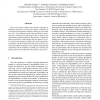Free Online Productivity Tools
i2Speak
i2Symbol
i2OCR
iTex2Img
iWeb2Print
iWeb2Shot
i2Type
iPdf2Split
iPdf2Merge
i2Bopomofo
i2Arabic
i2Style
i2Image
i2PDF
iLatex2Rtf
Sci2ools
DSN
2006
IEEE
2006
IEEE
Collecting and Analyzing Failure Data of Bluetooth Personal Area Networks
This work presents a failure data analysis campaign on Bluetooth Personal Area Networks (PANs) conducted on two kind of heterogeneous testbeds (working for more than one year). The obtained results reveal how failures distribution are characterized and suggest how to improve the dependability of Bluetooth PANs. Specifically, we define the failure model and we then identify the most effective recovery actions and masking strategies that can be adopted for each failure. We then integrate the discovered recovery actions and masking strategies in our testbeds, improving the availability and the reliability of 3.64% (up to 36.6%) and 202% (referred to the Mean Time To Failure), respectively.
| Added | 11 Jun 2010 |
| Updated | 11 Jun 2010 |
| Type | Conference |
| Year | 2006 |
| Where | DSN |
| Authors | Marcello Cinque, Domenico Cotroneo, Stefano Russo |
Comments (0)

